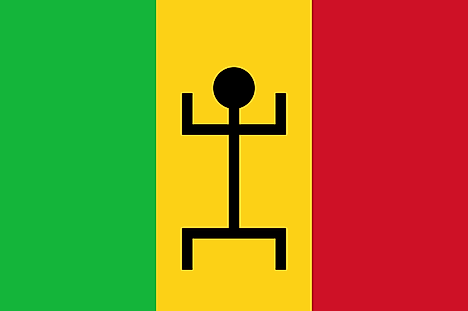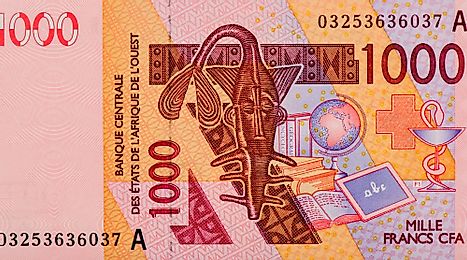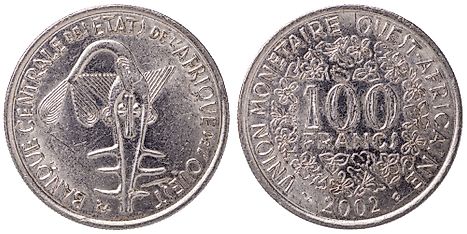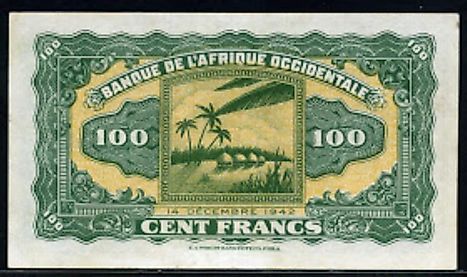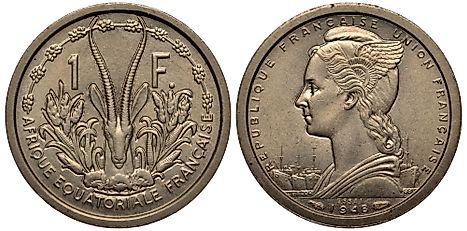Flags, Symbols & Currency of Senegal
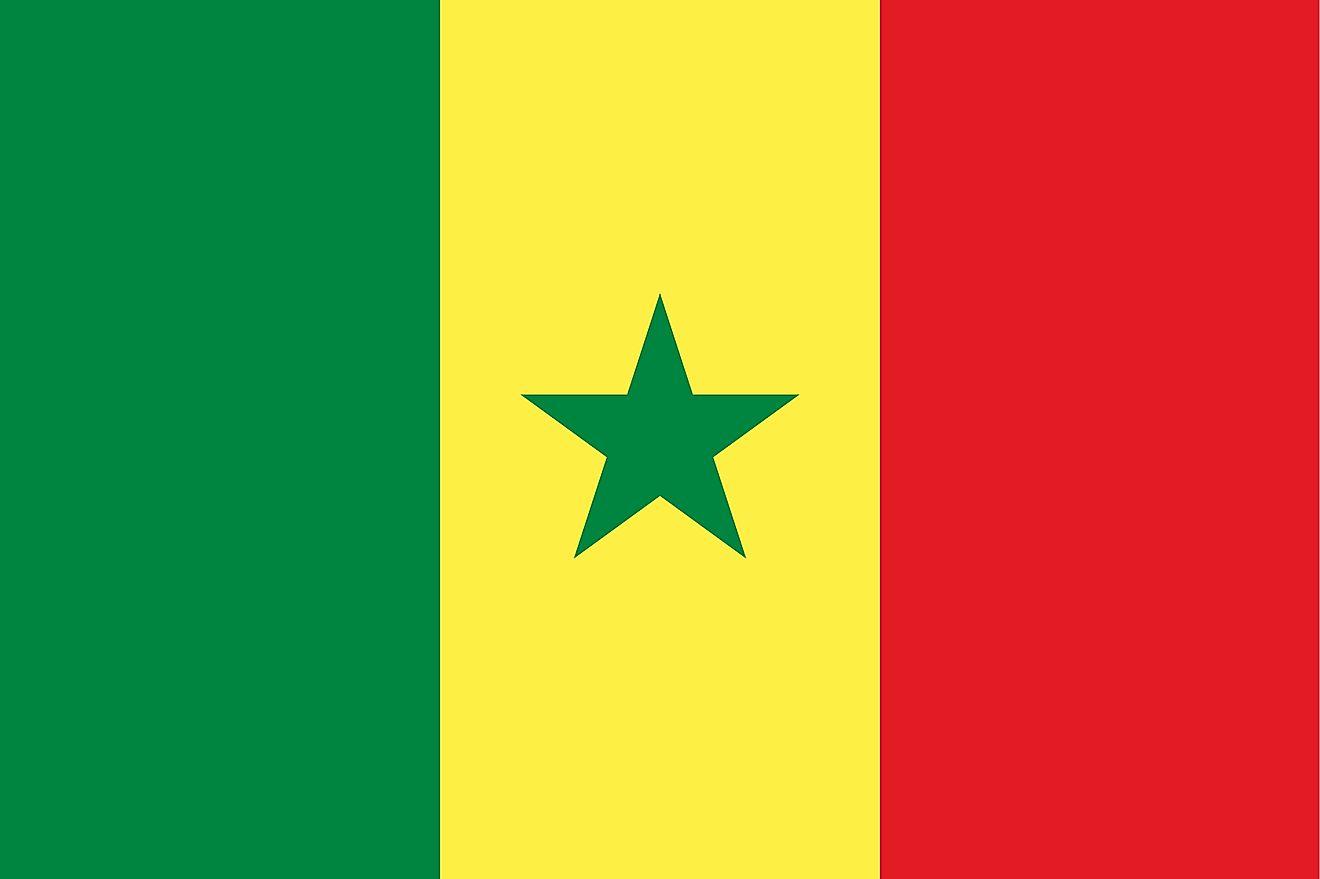
The National Flag of Senegal was officially adopted on August 20, 1960.
The National Flag of Senegal is a tricolor and features three equal vertical bands of green (hoist side), yellow, and red with a small green five-pointed star centered in the yellow band. The colors of the flag are also regarded as the Pan-African colors, and the colors also represent the three political parties that merged to form the Senegalese Progressist Union. The green color represents the religion of Islam and is regarded as the color of the Prophet. It also symbolizes progress and hope. The yellow color signifies natural wealth and intellect, arts, and literature. The red color symbolizes the sacrifice and the color of life. It also signifies the strong determination of the Senegalese to overcome all obstacles and prosper. The star is symbolic of unity and hope. The flag has a width-to-length proportion ratio of 2:3.
History of the Flag of Senegal
In the 19th century, France colonized the entire region of Senegal. During the French rule, the French authorities forbade the use of a flag in the country. They were worried that a unique flag would encourage nationalistic sentiments among the natives. In 1959, the Mali Federation was formed where French Soudan and Senegal were unified to create a self-governing republic under French rule. A new flag was then adopted to represent the republic. The flag was designed after the French Tricolore and consisted of green-yellow-red colors featuring a stylized human figure in the yellow band. On June 20, 1960, the federation achieved independence from French rule. Two months later, French Soudan and Senegal separated, and on August 20 of that year, Senegal emerged as a fully independent nation. The flag of Senegal was similar to the of the federation but only had a green star in place of the stylized human figure.
Symbols of Senegal
The National Coat of Arms of Senegal
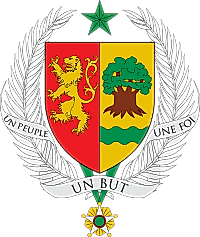
The National Coat of Arms of Senegal was adopted in 1965 and was designed by Suzanne Gauthier. It features a shield depicting the Pan-African colors – red, green, and yellow. Above the shield is a green five-pointed star which represents Islam and symbolizes unity and hope. The left half of the shield contains a lion and the right half contains a baobab tree. The lion symbolizes strength and represents the ethnic northern Sengalaese group. The baobab tree is an indigenous tree of Senegal. Beneath the baobab tree, the wavy green lines allude to the Senegal River. Below the shield is an Order which represents the Star of the Ordre National du Lion. The Palm leaves flank the shield with the national motto: Un Peuple, Un But, Une Foi ("One People, One Goal, One Faith").
National Motto
Un Peuple, Un But, Une Foi ("One People, One Goal, One Faith")
National Anthem
- Anthem Title: “Pincez Tous vos Koras, Frappez les Balafons”
- Music Composer: Herbert Pepper
- Lyricist: Léopold Sédar Senghor
- Date of Adoption: 1960
“Pincez Tous vos Koras, Frappez les Balafons” is the national anthem of Senegal. The music of the anthem have been composed by Herbert Pepper. The lyrics of the anthem have been authored by Léopold Sédar Senghor. The anthem was officially adopted in 1960.
“Pincez Tous vos Koras, Frappez les Balafons” (French)
1.
Pincez tous vos Koras, frappez les balafons.
Le lion a rugi.
Le dompteur de la brousse
D’un bond s’est élancé
Dissipant les ténèbres.
Soleil sur nos terreurs, soleil sur notre
espoir.
Debout, frères, voici l’Afrique rassemblée
Chorus:
Fibres de mon coeur vert.
Épaule contre épaule, mes plus que frères,
O Sénégalais, debout!
Unissons la mer et les sources,unissons la
steppe et la forêt!
Salut Afrique mère, salut Afrique mère.
2.
Sénégal toi le fils de l’écume du Lion,
Toi surgi de la nuit au galop des chevaux,
Rend-nous, oh! rends-nous l’honneur de nos
Ancêstres,
Splendides comme ébène et forts comme le
muscle
Nous disons droits-l’épée n’a pas une
bavure.
Chorus
3.
Sénégal, nous faisons nôtre ton grand
dessein:
Rassembler les poussins à l’abri des milans
Pour en faire, de l’Est à l’Ouest, du Nord au
Sud,
Dressé, un même peuple, un peuple sans
couture
Mais un peuple tourné vers tous les vents du
monde.
Chorus
4.
Sénégal, comme toi, comme tous nos héros,
Nous serons durs sans haine et des deux bras ouverts.
L’épée, nous la mettrons dans la paix du fourreau,
Car le travail sera notre arme et la parole.
Le Bantou est un frère, et l’Arabe et le Blanc.
Chorus
5.
Mais que si l’ennemi incendie nos frontières
Nous serons tous dressés et les armes au poing:
Un Peuple dans sa foi défiant tous les malheurs,
Les jeunes et les vieux, les hommes et les femmes.
La Mort, oui! Nous disons la Mort, mais pas la honte.
Chorus
“Pluck Your Koras, Strike the Balafons”
1.
Sound, all of you, your Koras,
Beat the drums,
The red Lion has roared,
The Tamer of the bush with one leap has
rushed forward,
Scattering the gloom.
Light on our terrors,
Light on our hopes.
Arise, brothers, behold Africa united!
Chorus:
Fibres of my green heart.
Shoulder to shoulder,
O people of Senegal, more than brothers to
me, arise!
Unite the sea and the springs,
Unite the steppe and the forest!
Hail, mother Africa, Hail, mother Africa!
2.
Senegal, thou son of the Lion
Arise in the night with great speed,
Restore, oh, restore to us the honour of our
ancestors,
Magnificent as ebony and strong as
muscles!
We are a straight people-the sword has no
fault.
Chorus
3.
Senegal, we make your great design our
own:
To gather the chicks, sheltering them from
kites,
To make from them, from East to West, from
North to South,
A people rising as one, in seamless unity,
Yet a people facing all the winds of the earth.
Chorus
4.
Senegal, like thee, like all our heroes,
We will be stern without hatred, and with open arms.
The sword we will put peacefully in its sheath,
For work and words will be our weapon.
The Bantu is our brother, the Arab, and the White man too.
Chorus
5.
But if the enemy violates our frontiers,
We will all be ready, weapons in our hands;
A people in its faith defying all evil;
Young and old, men and women,
Death, yes! but not dishonour.
Chorus
The Currency of Senegal is the West African CFA franc
The West African CFA franc is the official currency used by Senegal and seven other nations situated in western Africa that form the African Financial Community. The BCEAO (Banque Centrale des États de l'Afrique de l'Ouest) [The Central Bank of the West African States] issues the currency.
The initials CFA represents the Communauté Financière d'Afrique, a Central Bank situated in Senegal in the city of Dakar. The West African CFA franc is a stable currency, which has enabled economies to experience steady growth.
Coins:
Coins of the West African CFA franc exist in the forms of 1, 5, 10, 25, 50, 100, 200, 250, and 500 francs.
Banknotes:
Banknotes of the West African CFA franc exist in the forms of 500, 1000, 2000, 5000, and 10,000 francs.
50-franc banknotes were last issued in 1959, and 100-franc banknotes were last issued in 1965. The 10,000-franc note has existed since 1977.
Senegal is one of the first African countries to introduce a digital currency both in Africa and abroad. The e-CFA was developed through collaboration between the eCurrency Mint Limited and the Banque Regionale de Marches. The currency, launched in 2016 and set to be in circulation in 2017, is a unique creation of the digital currency in that the central bank has control over the supply of money. The currency is also bound by e-money regulations by the Central Bank of West African States. The Senegalese currency offers a lot of flexibility in use as the currency and makes transactions across different banks and mobile money platforms possible.
Historical currencies of Senegal
The West African colonies of France used the French West African franc as their currency. The currency was introduced in the colonies in 1903 and used until 1945 when the CFA franc was introduced. The Bank of West Africa distributed the coins and notes of the currency in various denominations. Coins were made from aluminum and bronze and came in denominations of 50 centimes and 1 franc. Notes came in denominations of 1, 2, 5, 10, 50, and 100 francs. Senegal uses the West African CFA franc as its official legal tender since its introduction in 1945. Senegal also depends on economic aid from developed nations.

